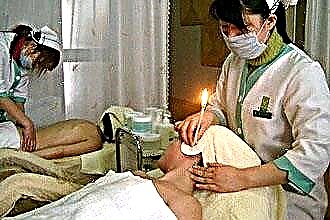Relatively recently, an unusual remedy has appeared for the treatment and cleansing of the ears from sulfur and sulfur plugs - the so-called ear candles. At first, they were made by hand, from wax, fabric and other components. Now in pharmacies you can find ready-made ear candles of various diameters with various additives.

It should be noted that this remedy is not included in the standard therapy for ear diseases and belongs to folk or alternative medicine. Many doctors are skeptical about ear candles, and some even insist that their manufacture and sale be banned. Reviews about this tool are controversial - there are both satisfied and disappointed patients.
How do ear candles work? What is the reason for the mistrust of doctors in this remedy? What are the indications and contraindications for their use? We will tell you under what conditions and how to use ear candles.
What is an ear candle?
An ear candle is a hollow wax tube that is wrapped in a cloth and impregnated with various substances (but it can be without additives). Beeswax ear suppositories may contain:
- propolis;
- essential oils of plants - lavender, eucalyptus, cinnamon, mint, etc .;
- dry medicinal herbs;
- plant extracts.
When heated, essential oils evaporate, providing various effects - soothing, deodorant, immunostimulating, warming, etc.
The product is intended for medical and hygienic procedures. The candle is inserted into the ear and set on fire. The fabric slows down the burning and melting of the wax, so that the ear warms up evenly and gradually. According to the manufacturers, during combustion, a reverse thrust is formed in the cavity of the tube, pushing out sulfur and foreign objects from the ear.
Thus, thanks to the procedure, the following effects are achieved:
- warming up the ear;
- softening of earwax;
- cleansing the deep parts of the ear canal from sulfur, pushing it to the auricle;
- reducing pain;
- soothing effect (thanks to volatile essential oils).

Indications for use
What are ear candles used for? According to the instructions, they are used:
- to remove plugs from wax in the ear canal;
- with otitis media and inflammation of the Eustachian tube;
- with inflammation of the paranasal sinuses;
- to reduce tinnitus and congestion;
- with headache;
- to relieve stress, insomnia, etc.
In most cases, they play the role of an aid.
Suppositories cannot kill an infection in the middle ear or sinuses — these require antibiotics and other medications. That is why suppositories are used in combination with the treatment prescribed by a doctor.
It is necessary to notify the attending physician that you are using this drug - it may not work well with your prescribed medications, or is contraindicated in your case.
How to put candles for your ears?
When using ear candles, you must follow the instructions for use:
- The procedure should not be carried out on your own. The person to whom the candle will be placed ("the patient") lies on his side, and someone close to him (an adult!) Prepares everything necessary - 2 candles, matches, a napkin made of natural fiber, a glass of water.
- A napkin with an ear slot should be placed on the patient's head. The napkin should be made of natural, hard-to-ignite material (for example, flax).
- The patient's auricle is lightly massaged with a small amount of baby cream.
 A candle is inserted shallowly into the ear canal. It should be adhered to during the procedure.
A candle is inserted shallowly into the ear canal. It should be adhered to during the procedure.- The opposite end of the candle is lit. During combustion, be careful with wax droplets and fire so that the patient does not get burned.
- When the fire reaches the mark, the candle must be extinguished (for example, in a glass of water).
- The auricle is cleaned of softened sulfur using a cotton swab (always with a stopper).
- A cotton swab is inserted into the ear.
- The procedure is repeated for the other ear.
- After 15 minutes, the tampons are removed. It is not recommended to go outside, take a shower and engage in vigorous physical activity for several hours after the procedure, so it is best to do it before bedtime.
Some of the nuances of using products of different brands are different, so carefully read the manufacturer's instructions before using.
Contraindications and precautions
The instruction says that ear candles are contraindicated in such conditions:
- intolerance to honey, beeswax or propolis;
- purulent otitis media;
- violation of the integrity of the tympanic membrane;
- diseases of the skin of the auricles - psoriasis, eczema, furunculosis, acne, fungal infection, etc.;
- tumor diseases of the head or ears;
- in children - fear of fire, hyperactivity and restlessness.
Why don't doctors recommend this remedy? The instruction for ear wax candles states that this remedy is absolutely safe, but it is not. Firstly, burning a fire in close proximity to hair, eyes and ear is already a risk factor, especially when it comes to children. Secondly, hot ash or molten wax can enter the ear canal during the procedure. Otolaryngologists are often faced with such cases. Pulling hardened wax out of your ear canal is not as easy as it sounds. Even an ENT specialist may require several procedures for this. By trying to remove wax with a cotton swab, patients only exacerbate the problem - the cotton swab pushes the wax deeper into the ear canal.
Thus, the consequences of self-medication in this way are very deplorable. We are not talking about the effectiveness of ear suppositories - this issue is not well understood, but it can be argued that their safety leaves much to be desired.
It is permissible to carry out such a procedure only under the supervision of an otolaryngologist. Currently, the pharmaceutical industry offers a wide range of more reliable and safer products for both ear wax removal and treatment.

 A candle is inserted shallowly into the ear canal. It should be adhered to during the procedure.
A candle is inserted shallowly into the ear canal. It should be adhered to during the procedure.

